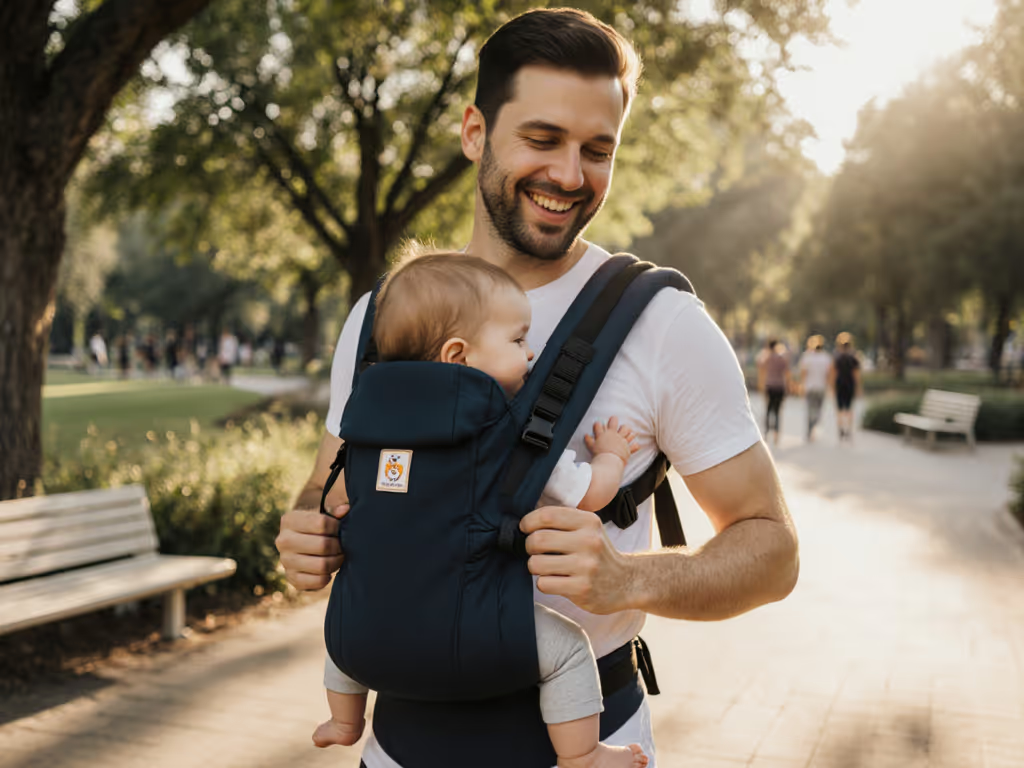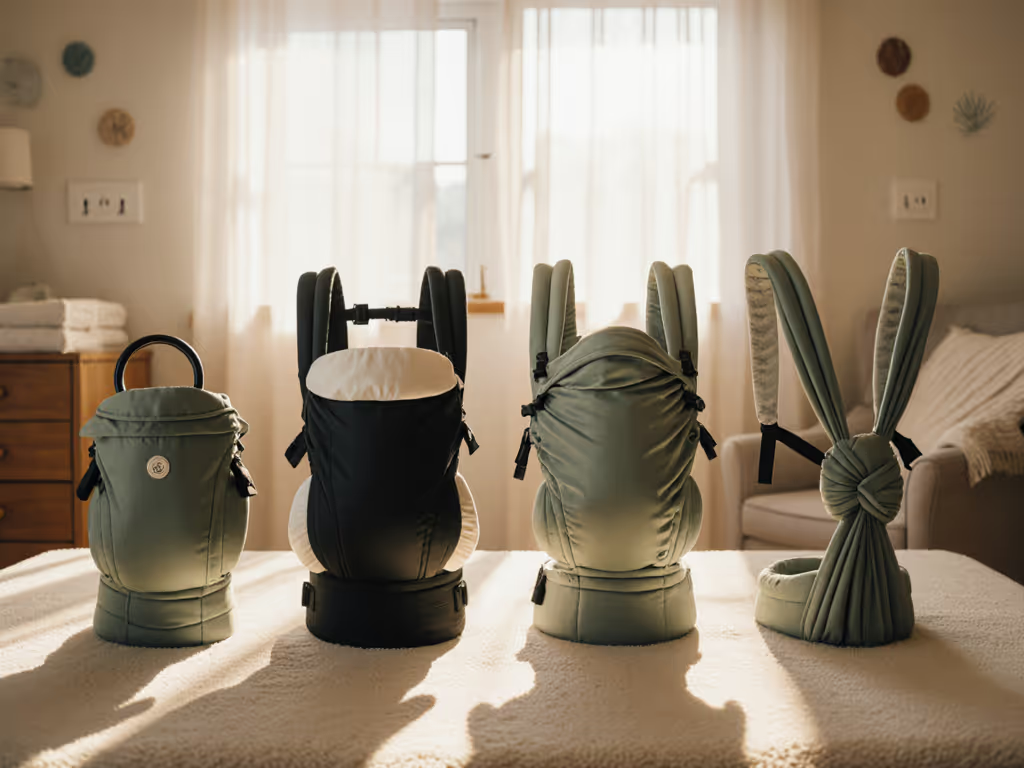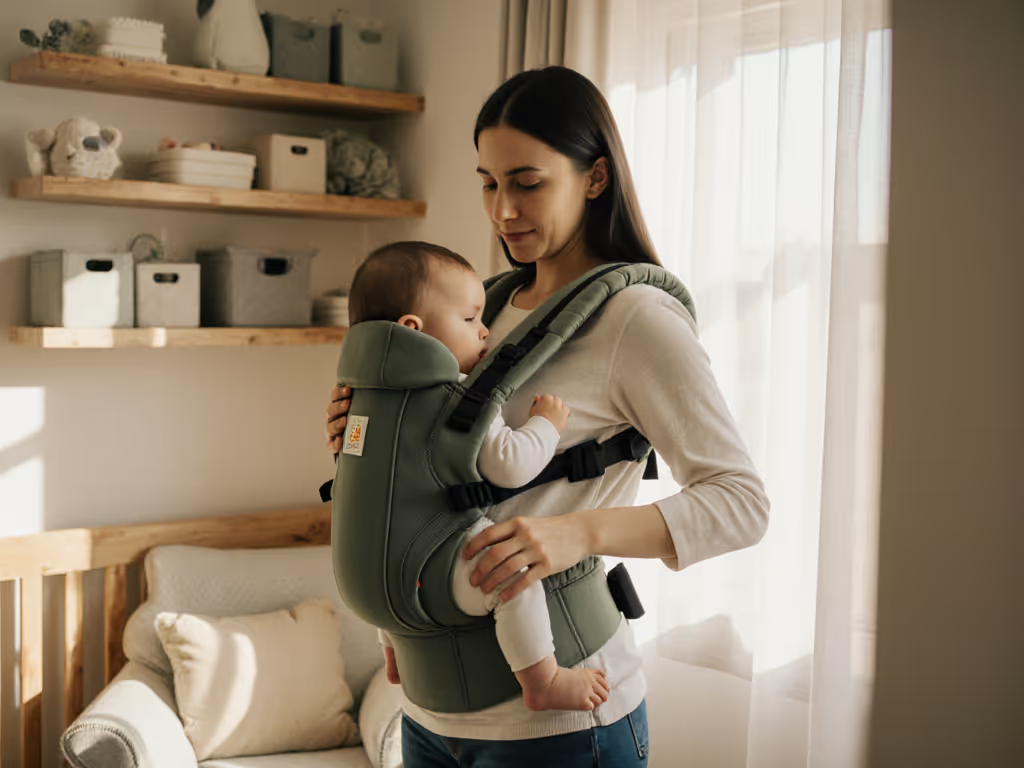
7 Essential Babywearing Tips for Dads: Confident and Safe Carry

Did you know that dads who wear their babies report feeling more connected and confident in their parenting role? Babywearing is not just about convenience, it promotes bonding and supports healthy development for your child. With the huge variety of carriers and techniques available, knowing how to choose and use the right one makes a big difference for both comfort and safety. Discover straightforward steps every father can use to make babywearing enjoyable and stress free.
Quick Summary
| Takeaway | Explanation |
|---|---|
| 1. Choose the right carrier based on body type. | Different body shapes require different carriers for optimal comfort and support during babywearing. |
| 2. Understand the TICKS rule for safety. | The TICKS rule outlines essential safety principles ensuring both comfort and proper positioning for the baby. |
| 3. Master putting on and adjusting your carrier. | Practice helps build confidence and familiarity with the carrier, ensuring proper use and less discomfort. |
| 4. Dress appropriately for varying weather conditions. | Choosing the right clothing layers helps manage temperatures for both the dad and baby during babywearing. |
| 5. Engage in babywearing groups for support. | Joining a community provides valuable knowledge, practical tips, and emotional support from other parents. |
1. Choose the Right Carrier for Dad's Body Type
Not all baby carriers are created equal and one size definitely does not fit all dads. Your body shape weight distribution and personal comfort are crucial factors in selecting the perfect baby carrier that will make both you and your little one happy.
Body mechanics play a significant role in carrier selection. Broader shouldered dads might find structured carriers more comfortable while slimmer or shorter dads could prefer wrap style carriers that adjust more flexibly. Think of it like choosing the right workout gear your carrier should feel like a natural extension of your body.
When selecting a carrier consider these key physical attributes:
- Shoulder Width: Wider straps distribute weight better for broader shoulders
- Torso Length: Ensure the carrier sits comfortably without bunching or riding up
Pro Tip: Try on multiple carriers before purchasing. Most baby stores offer demonstration areas where you can test different styles with a weighted doll to simulate actual babywearing.
Remember comfort translates directly into confidence. A carrier that feels awkward or causes strain will discourage you from babywearing which defeats the entire purpose of creating those precious bonding moments with your child.
Pro tip: Your physical comfort matters just as much as your baby's. A well fitted carrier means you can walk confidently chase after toddlers or navigate busy spaces without constant readjustment.
2. Learn Safe Baby Positioning and Support
Babywearing is an art form that requires precision and care especially when it comes to positioning your little one securely. Understanding proper baby positioning is not just about comfort its about ensuring your baby's safety and physical development.
The TICKS Rule provides a critical framework for safe babywearing that every dad should memorize. This rule outlines five key principles that transform babywearing from a simple task to a safe bonding experience:
- Tight: Your carrier should be snug to prevent baby from slumping
- In View: Always keep your baby's face visible
- Close Enough to Kiss: Position baby near enough to kiss their head
- Keep Chin Off Chest: Maintain an open airway
- Supported Back: Ensure baby's back remains in its natural position
Newborn and infant positioning requires special attention. Vertical positioning is crucial for protecting your baby's developing spine and ensuring proper breathing. Imagine creating a natural M shape with your baby's body where their knees are higher than their bottom providing optimal hip and spine support.
Pro Tip: Regularly check your baby's position during wear. A quick visual and physical check can prevent potential breathing restrictions or uncomfortable positioning.
While nursing your baby might temporarily shift to a horizontal position this should be brief. Always return to an upright position that keeps airways open and provides full body support. Your vigilance protects your baby's delicate respiratory and muscular systems during these precious early months.
3. Practice Putting On and Taking Off with Confidence
Mastering baby carrier techniques is like learning any new skill practice makes perfect. Before venturing out into the world with your little one you need to build muscle memory and confidence in a safe environment.
Start Small and Strategic: Begin your practice sessions without your baby. Use a stuffed animal or doll to simulate the weight and positioning. This approach allows you to familiarize yourself with buckles straps and fabric movements without the added complexity of managing an actual infant.
Practice Zones are critical for building your skills:
- Home Base: Start in front of a mirror
- Soft Landing Area: Practice over a bed or couch
- Spotter Recommended: Have a partner or friend assist you
Back Carries Require Extra Caution. Do not attempt back carries until you have mastered front carries and feel completely comfortable. When you do start practicing back carries always use a spotter and practice low to the ground over a soft surface.
Muscle Memory Techniques:
- Practice your specific carrier type multiple times
- Watch tutorial videos specific to your carrier model
- Time yourself to build speed and confidence
Remember your first attempts will feel awkward. This is normal. Professional athletes practice moves hundreds of times before mastering them and babywearing is no different. Give yourself grace patience and plenty of practice time.
4. Adjust Straps for Comfort and Back Support
Your baby carrier is only as good as its fit and proper strap adjustment can make the difference between a comfortable babywearing experience and a painful ordeal. Think of carrier straps like the suspension system on a high performance vehicle they distribute weight support your body and prevent unnecessary strain.
Weight Distribution Matters. Improperly adjusted straps can cause significant back pain and discomfort. The goal is to spread your baby's weight across your shoulders and lower back creating a balanced supportive carry that feels natural and effortless.
Key Strap Adjustment Strategies:
- Shoulder Alignment: Straps should sit midway between your neck and shoulder edge
- Strap Width: Ensure straps are wide enough to prevent digging into shoulders
- Lumbar Support: Adjust waist straps to sit at your natural waistline
Crossing Straps Technique: For additional comfort and weight distribution consider crossing shoulder straps. This method creates a more ergonomic carry that reduces pressure points and helps center your baby's weight more effectively.
Pro Tips for Perfect Fit:
- Perform a quick bounce test after adjusting straps
- Check for any pinching or uncomfortable pressure points
- Readjust straps if you feel any uneven weight distribution
Remember babywearing is a skill that improves with practice. Your first few carries might feel awkward but with consistent adjustment and attention to comfort youll soon find your perfect fit.
5. Dress Appropriately for Various Weather Conditions
Babywearing introduces a whole new dimension to dressing strategically. Your clothing choices impact both your comfort and your baby's temperature regulation more significantly than you might realize.
Layering is Your Secret Weapon. Think of babywearing as creating a microclimate between you and your little one. The carrier itself acts as an additional layer generating warmth and reducing the number of extra clothing pieces you need.
Temperature Management Strategies:
- Cool Weather: Wear a lightweight jacket that zips over both you and baby
- Warm Weather: Choose breathable mesh carriers with moisture wicking properties
- Extreme Temperatures: Consider specialized carrier covers or weather shields
Fabric Selection Matters. Opt for moisture wicking lightweight materials that allow air circulation. Some modern carriers feature specialized Cool Mesh panels designed to provide extra airflow preventing overheating for both parent and child.
Practical Tips for Weather Adaptability:
- Check fabric composition of your carrier
- Bring an extra lightweight layer for quick temperature changes
- Monitor your baby's temperature through clothing and skin contact
Remember babies cannot regulate temperature as effectively as adults. Your clothing choices directly impact their comfort and safety. A thoughtful approach to dressing means you can confidently carry your baby in almost any weather condition.
6. Get Involved in Babywearing from the Start
Babywearing is not just about transportation. It is a powerful bonding experience that allows fathers to create deep emotional connections with their newborns from the very beginning. Your active involvement signals to your baby that you are a primary source of comfort and security.
Early Engagement Matters. Babies recognize their fathers through touch sound and proximity. Babywearing provides an incredible opportunity to establish a strong sensory connection that goes beyond traditional caregiving methods.
Key Bonding Strategies:
- Consistent Presence: Wear your baby during routine activities
- Skin to Skin Contact: Use carriers that allow direct contact
- Talk and Move: Narrate your actions while wearing your baby
Positioning is Critical. Follow the TICKS rule meticulously when carrying your infant. Always maintain an upright position except during active nursing. Return to upright positioning immediately after feeding to ensure proper respiratory and muscular support.
Fathers often feel uncertain about their caregiving role. Babywearing breaks down these barriers by providing a tangible way to nurture and protect. Your physical closeness communicates safety comfort and love more powerfully than words ever could.
Remember every moment you spend close to your baby builds neural pathways of trust. You are not just carrying a child you are constructing the foundation of a lifelong relationship.
7. Join Babywearing Groups for Support and Guidance
Navigating the world of babywearing can feel overwhelming particularly for new dads. Joining a supportive community can transform your learning experience from intimidating to empowering providing practical skills and emotional reassurance.
Community Learning Accelerates Confidence. Babywearing groups offer more than just technical advice. They provide a judgment free environment where fathers can share experiences practice techniques and learn from seasoned parents who have walked the same path.
Benefits of Joining Babywearing Communities:
- Expert Guidance: Access to Volunteer Babywearing Educators
- Hands On Learning: Live demonstrations and practice sessions
- Peer Support: Connect with other fathers experiencing similar challenges
Where to Find Support:
- Local parenting centers
- Online forums dedicated to babywearing
- Babywearing International meetup groups
- Social media communities focused on father childcare
Professional Insight. Organizations like Babywearing International offer structured meetings where trained educators can provide personalized guidance. These sessions allow you to practice new carrying techniques with immediate professional feedback reducing potential safety risks.
Remember learning is a journey. Every experienced dad was once a beginner. These groups exist to help you build skills confidence and create beautiful bonding moments with your child.
Below is a comprehensive table summarizing the main tips and strategies for babywearing as discussed in the article.
| Topic | Key Points & Strategies | Benefits/Outcomes |
|---|---|---|
| Choosing the Carrier | Consider body type and try different carriers. Broader shoulders may prefer structured carriers; slimmer builds might opt for wrap styles. | Enhanced comfort and confidence during babywearing. |
| Safe Baby Positioning | Follow the TICKS rule: Tight, In view, Close enough to kiss, Keep chin off chest, Supported back. | Ensures baby’s safety and supports physical development. |
| Practice Techniques | Start with a stuffed animal, use a mirror, practice in safe environments with a spotter. | Builds confidence and muscle memory for efficient handling. |
| Strap Adjustment | Properly adjust straps for weight distribution and consider crossing straps. | Prevents back pain and provides a comfortable, balanced carry. |
| Dressing for Weather | Use layering, choose breathable fabrics, and check fabric composition. | Maintains comfort and regulates temperature effectively for both parent and baby. |
| Bonding through Babywearing | Engage in consistent presence, skin-to-skin contact, and communication. | Strengthens emotional connections and builds trust with the baby. |
| Community Support | Join babywearing groups for peer support, guidance, and practice. | Gained confidence and improved skills through shared experiences and expert advice. |
Boost Your Babywearing Confidence with Expert Guidance
Navigating the challenges of choosing the right carrier, mastering safe baby positioning, and adjusting straps for comfort can feel overwhelming. This article highlights the importance of finding a carrier that suits your body type and learning the TICKS rule to keep your baby safe and supported. If you want to eliminate the guesswork and enjoy every bonding moment without discomfort or worry, you need a trusted resource designed just for dads like you.
Explore Caregiver Carry, your dedicated platform for evidence-based babywearing advice. From detailed guides on carrier selection and safety checklists to independent reviews, it provides everything you need to carry your baby confidently in any weather. Don’t wait to make babywearing a joyful experience. Visit Caregiver Carry now to get the personalized support and expert tips that will transform how you connect with your child every day.
Frequently Asked Questions
How do I choose the right baby carrier for my body type as a dad?
Choosing the right baby carrier depends on your body shape and comfort. Consider trying multiple carriers that suit your shoulder width and torso length to find the best fit. Visit a baby store with demonstration areas and test different styles to see what feels most comfortable.
What is the TICKS rule for baby positioning in carriers?
The TICKS rule ensures your baby's safety and comfort in the carrier. Make sure the carrier is tight, your baby's face is in view, they're close enough to kiss, their chin is off their chest for an open airway, and their back is well-supported. Review this rule regularly to maintain proper positioning during babywearing.
How can I practice putting on and taking off the carrier confidently?
Start by practicing without your baby, using a stuffed animal or doll for weight simulation. Familiarize yourself with the buckles and straps in a safe environment, like in front of a mirror or over a soft surface, until you feel comfortable. Set aside time each day to repeat this practice, which will help build muscle memory and confidence.
What are the best adjustments to make for comfort and back support in a baby carrier?
To ensure comfort and prevent back pain, adjust the shoulder straps so they sit midway between your neck and shoulders. Test the fit with a quick bounce after adjustments to confirm even weight distribution. Regularly check for any pinching to maintain support during your babywearing experience.
How should I dress my baby and myself for different weather conditions while babywearing?
Layering clothing is essential for managing temperature while babywearing. In cooler weather, wear a lightweight jacket that covers both you and the baby, and in warm weather, choose breathable carriers. Always monitor your baby's temperature and bring an extra layer for quick adjustments as conditions change.
Why is it important for dads to get involved in babywearing from the start?
Getting involved in babywearing establishes a strong bond between you and your baby by providing comfort and security. Your physical presence and proximity allow babies to recognize you through touch and sound. Engage consistently in routine activities while wearing your baby to deepen this connection.



